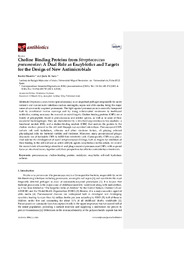Por favor, use este identificador para citar o enlazar este ítem:
https://hdl.handle.net/11000/4587Registro completo de metadatos
| Campo DC | Valor | Lengua/Idioma |
|---|---|---|
| dc.contributor.author | Maestro García-Donas, Beatriz | - |
| dc.contributor.author | Sanz, Jesús M. | - |
| dc.contributor.other | Departamentos de la UMH::Bioquímica y Biología Molecular | es |
| dc.date.accessioned | 2018-04-10T11:37:35Z | - |
| dc.date.available | 2018-04-10T11:37:35Z | - |
| dc.date.created | 2016-05-16 | - |
| dc.date.issued | 2018-04-10 | - |
| dc.identifier.issn | 2079-6382 | - |
| dc.identifier.uri | http://hdl.handle.net/11000/4587 | - |
| dc.description.abstract | Streptococcus pneumoniae (pneumococcus) is an important pathogen responsible for acute invasive and non-invasive infections such as meningitis, sepsis and otitis media, being the major cause of community-acquired pneumonia. The fight against pneumococcus is currently hampered both by insufficient vaccine coverage and by rising antimicrobial resistances to traditional antibiotics, making necessary the research on novel targets. Choline binding proteins (CBPs) are a family of polypeptides found in pneumococcus and related species, as well as in some of their associated bacteriophages. They are characterized by a structural organization in two modules: a functional module (FM), and a choline-binding module (CBM) that anchors the protein to the choline residues present in the cell wall through non-covalent interactions. Pneumococcal CBPs include cell wall hydrolases, adhesins and other virulence factors, all playing relevant physiological roles for bacterial viability and virulence. Moreover, many pneumococcal phages also make use of hydrolytic CBPs to fulfill their infectivity cycle. Consequently, CBPs may play a dual role for the development of novel antipneumococcal drugs, both as targets for inhibitors of their binding to the cell wall and as active cell lytic agents (enzybiotics). In this article, we review the current state of knowledge about host- and phage-encoded pneumococcal CBPs, with a special focus on structural issues, together with their perspectives for effective anti-infectious treatments | en |
| dc.description.sponsorship | This work was supported by grant BIO2013-47684-R (Spanish Ministry of Economy and Competitiveness) | - |
| dc.description.sponsorship | This work was supported the Resource for Biocomputing, Visualization, and Informatics at the University of California, San Francisco (supported by NIGMS P41-GM103311). | - |
| dc.format | application/pdf | en |
| dc.format.extent | 32 | es |
| dc.language.iso | eng | en |
| dc.rights | info:eu-repo/semantics/openAccess | en |
| dc.subject | pneumococcus | en |
| dc.subject | choline-binding protein | en |
| dc.subject | endolysin | en |
| dc.subject | enzybiotic | en |
| dc.subject | cell-wall hydrolase | en |
| dc.subject | adhesin | en |
| dc.subject.other | 57 - Biología | es |
| dc.title | Choline Binding Proteins from Streptococcus pneumoniae: A Dual Role as Enzybiotics and Targets for the Design of New Antimicrobials | en |
| dc.type | info:eu-repo/semantics/article | en |
| dc.contributor.institute | Instituto de Biología Molecular y Celular | es |
| dc.identifier.doi | 10.3390/antibiotics5020021 | - |
| dc.relation.publisherversion | https://doi.org/10.3390/antibiotics5020021 | - |

Ver/Abrir:
2-antibiotics-124748-proof - 1.pdf
1,43 MB
Adobe PDF
Compartir:
 La licencia se describe como: Atribución-NonComercial-NoDerivada 4.0 Internacional.
La licencia se describe como: Atribución-NonComercial-NoDerivada 4.0 Internacional.
.png)